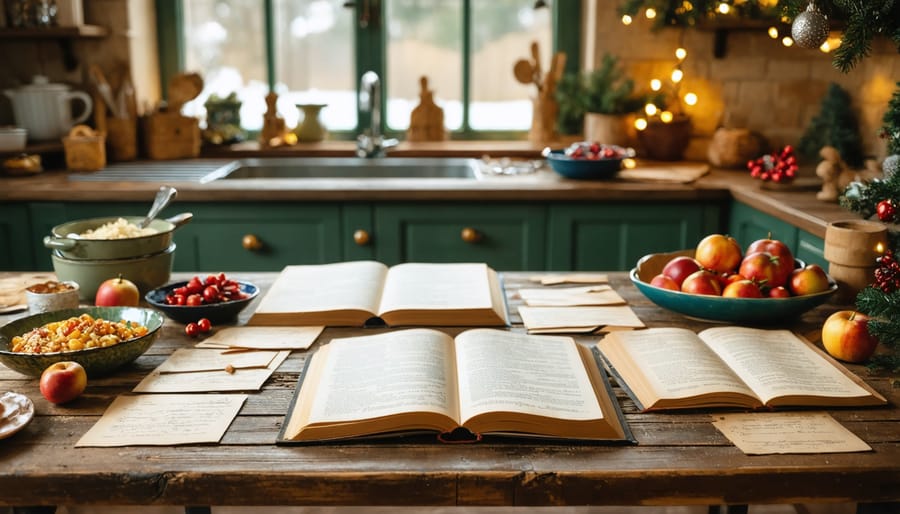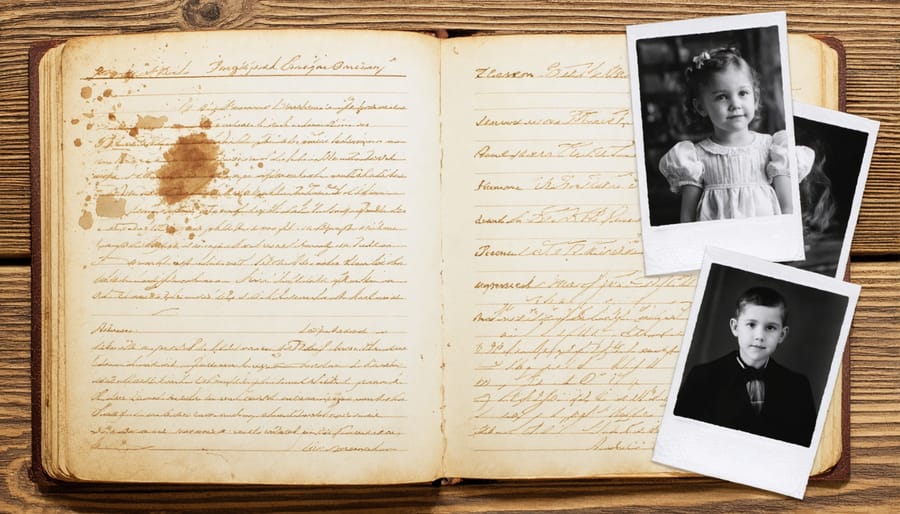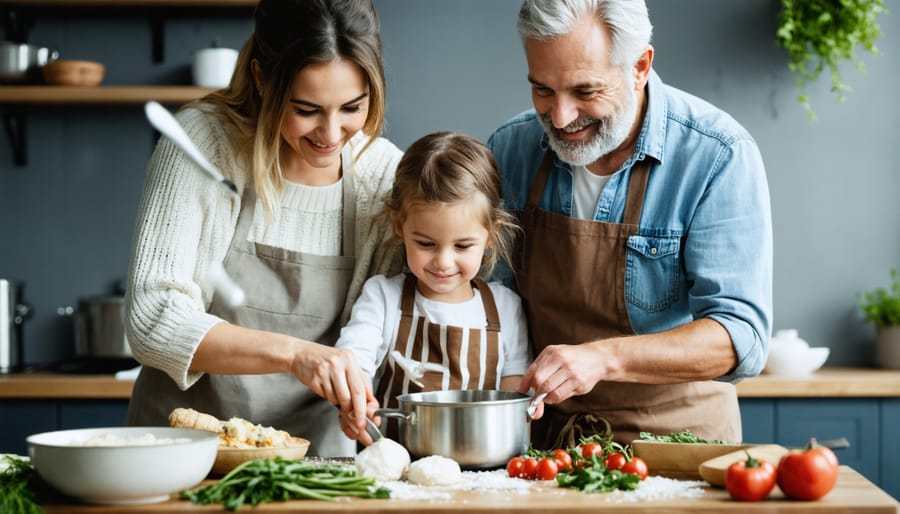
Transform your collection of cherished family recipes into a beautiful holiday recipe book that captures the magic of seasonal celebrations. Every December, as warm spices fill the air and memories flood the kitchen, these treasured recipes deserve more than just scattered notes and dog-eared cookbook pages. A personalized holiday recipe book becomes both a practical cooking guide and a family heirloom, preserving the stories behind Great-Grandma’s gingerbread cookies and Aunt Marie’s legendary stuffing.
Creating your own holiday recipe book isn’t just about organizing recipes – it’s about crafting a legacy of love, tradition, and culinary excellence that future generations will treasure. Whether you’re documenting decades-old family secrets or incorporating new holiday favorites, this collection will become the heart of your festive celebrations, ensuring that every special dish has its moment to shine, every measurement is precise, and every cherished memory remains alive through the food that brings us together.
Start your journey today by gathering those beloved recipes, capturing the stories behind them, and creating a lasting tribute to your family’s holiday food traditions. Your recipe book will become more than just a cooking guide – it will be a time capsule of joy, love, and the flavors that make your holidays uniquely special.
Why Start Your Holiday Recipe Book Now
Preserving Family Heritage
Every time I open my grandmother’s weathered recipe book, I’m transported back to her cozy kitchen, where the aroma of holiday spices filled the air. These cherished collections are more than just cooking instructions – they’re family time capsules that preserve our cultural traditions through food for generations to come.
When you create a holiday recipe book, you’re crafting a legacy that connects past, present, and future family members. Those handwritten notes in the margins, the slight modifications to make a dish “just right,” and even the food stains on well-loved pages tell stories of countless family gatherings and celebrations.
Think of your recipe book as a family museum, where each recipe is an artifact of your heritage. That special stuffing recipe your great-aunt perfected, or the unique way your mother glazes her holiday ham – these aren’t just cooking methods, they’re pieces of your family’s unique story.
By documenting these precious recipes, you’re ensuring that future generations can recreate not just the dishes, but the warmth and love that made them special in the first place.
Creating New Traditions
While our cherished family recipes hold a special place in our hearts, there’s something magical about blending the old with the new. I discovered this when I added my quinoa-stuffed butternut squash alongside Grandma’s classic turkey recipe – it created the perfect balance of tradition and innovation.
Consider dedicating a section of your recipe book to “New Traditions,” where modern interpretations can shine alongside heritage dishes. For instance, you might pair your great-aunt’s butter cookies with your gluten-free gingerbread recipe, or complement traditional stuffing with a wild rice and cranberry version that speaks to contemporary tastes.
Don’t be afraid to experiment with updated cooking methods either. Your grandmother’s slow-cooked green beans might find a delicious new life in an air fryer, while maintaining that familiar comfort-food essence. The key is to respect the heart of traditional recipes while embracing fresh ingredients and techniques that reflect your family’s evolving palate.
Remember, today’s creative twists on classic dishes could become tomorrow’s cherished traditions for the next generation.
Organizing Your Holiday Recipe Collection

Digital vs. Physical Format
When it comes to organizing your cherished holiday recipes, you’ve got two fantastic options: going digital or sticking with the timeless charm of physical recipe books. I’ve experimented with both, and there are definitely sweet spots for each approach!
Digital recipe collections offer incredible convenience – imagine having all your favorite holiday recipes right at your fingertips on your tablet or phone. You can easily search for specific recipes, scale ingredients instantly, and even share them with family members across the country. Plus, digital formats allow you to add beautiful photos of your creations and make quick updates when you perfect that sugar cookie recipe.
However, there’s something irreplaceable about a physical recipe book. Those sauce-splattered pages and handwritten notes in the margins tell stories of holidays past. I still treasure my grandmother’s hand-written recipe cards, complete with her elegant cursive and little notes about which desserts were everyone’s favorites. Physical books also make wonderful family heirlooms that can be passed down through generations.
Many home cooks, myself included, opt for a hybrid approach. We keep digital copies for convenience while maintaining a special physical collection of our most treasured family recipes. This way, you get the best of both worlds – the efficiency of digital organization and the heartwarming nostalgia of a traditional recipe book.
Essential Categories to Include
A well-organized holiday recipe book should include carefully curated categories that capture all your seasonal favorites. Start with Appetizers and Holiday Nibbles – those crowd-pleasing starters that set the festive mood. Include both cold options like cheese platters and hot bites like stuffed mushrooms.
Main Courses deserve their own special section, broken down by protein – turkey, ham, roasts, and vegetarian alternatives. Don’t forget to include those cherished family recipes that make an appearance year after year. Side Dishes need ample space too – from traditional stuffing to various potato preparations and seasonal vegetable dishes.
Create a dedicated Cookies and Treats section for all your holiday baking adventures. Whether it’s classic sugar cookies, gingerbread, or family-secret recipes passed down through generations, these sweet traditions deserve their spotlight. Include a Beverages category featuring both alcoholic and non-alcoholic options – from mulled wine to festive punches and hot chocolate variations.
Consider adding specialized sections like Breakfast and Brunch (perfect for Christmas morning), Make-Ahead Meals (essential for busy holiday prep), and Edible Gifts (those special treats you love sharing with neighbors and friends). Finally, include a Special Diets category to accommodate guests with dietary restrictions – ensuring everyone can participate in the holiday feast.
Remember to leave some blank pages in each category for new discoveries and recipe experiments that might become tomorrow’s traditions.

Making Your Recipe Book Personal
Adding Stories and Photos
Transform your recipe book into a cherished family keepsake by weaving in personal stories and photographs that create lasting memories. For each special recipe, add a small note about its origin – perhaps it’s Grandma’s signature pie that always marked the end of Thanksgiving dinner, or the cookie recipe your mom perfected after years of holiday baking sessions.
Include family photos that capture these precious cooking moments: snapshots of little helpers decorating cookies, multi-generational baking days, or the proud smiles around a perfectly roasted turkey. Don’t forget to add pictures of the finished dishes too! Consider creating dedicated “memory pages” between recipe sections where you can share holiday traditions, funny cooking mishaps, or heartwarming stories about how certain dishes became family favorites.
For a polished look, use acid-free paper for photos and write stories in archival-quality ink. You might also include blank spaces for future generations to add their own memories and photos, making your recipe book a living document that grows with your family. Remember, these personal touches transform a simple collection of recipes into a treasured family heirloom that captures the true spirit of holiday cooking.
Recipe Notes and Tips
Through years of collecting and organizing family recipes, I’ve discovered some helpful tricks that make the process smoother and more enjoyable. When copying down cherished recipes, always note who it came from and any special memories associated with the dish – these personal touches become precious over time. I’ve learned to leave extra space on recipe pages for modifications and notes; what works in one kitchen might need tweaking in another.
For heritage recipes that use outdated measurements like “a pinch” or “handful,” I recommend testing and converting them to standard measurements. However, keep the original version noted somewhere – there’s something special about seeing your grandmother’s handwriting mentioning a “butter portion the size of an egg.”
When it comes to organization, I’ve found that color-coding recipes by category (appetizers, mains, desserts) makes them easier to locate during busy holiday preparations. Consider laminating frequently used recipe cards or storing them in plastic sleeves to protect them from inevitable kitchen spills.
Don’t forget to include a section for “recipe rescue notes” – those last-minute substitutions or modifications that saved the day. These insights often become valuable family cooking secrets passed down through generations.
Sharing and Expanding Your Collection
Family Recipe Sharing Sessions
There’s something magical about gathering loved ones to share cherished recipes. Host a cozy afternoon tea or weekend brunch where family members bring their signature holiday dishes and the stories behind them. Set up a comfortable space with notepads, recipe cards, and maybe even a scanner for preserving handwritten favorites. Make it interactive by having each person demonstrate their cooking techniques or share special tips passed down through generations.
Consider recording these sessions on video to capture not just the recipes, but the precious memories and family history too. Create stations where younger family members can interview older relatives about holiday food traditions, ensuring these culinary treasures aren’t lost to time. Don’t forget to document any variations or “secret ingredients” that make each recipe unique to your family.
Turn these gatherings into regular events, perhaps quarterly, focusing on different holiday seasons and celebrations throughout the year. The shared experience of collecting recipes becomes a cherished tradition itself.

Modern Ways to Collaborate
Gone are the days of waiting for handwritten recipe cards in the mail! Technology has made it incredibly easy to gather cherished family recipes from relatives near and far. Create a shared digital folder using services like Google Drive or Dropbox where family members can upload photos of their recipe cards or type them directly. Video calls are perfect for cooking sessions with grandma, where you can record her demonstrating family classics while sharing stories behind each dish.
Consider starting a private family Facebook group or WhatsApp chat dedicated to recipe sharing. Many families even use collaborative recipe apps that allow multiple contributors to add, comment, and adjust recipes together. For those tech-savvy relatives, encourage them to send voice notes explaining their cooking techniques – there’s something special about hearing their instructions in their own words.
Don’t forget to back up all digital contributions and consider creating both digital and printed versions of your final recipe collection.
Preserving Your Recipe Book for Future Generations
Your holiday recipe book is more than just a collection of recipes – it’s a treasure trove of meaningful family traditions that deserves to be preserved for generations to come. Here are some tried-and-true methods to ensure your precious recipes stand the test of time.
First, consider digitizing your recipes. Take clear photos or scan each page, including those charming handwritten notes and food stains that tell their own stories. Store these digital copies in multiple places – cloud storage, external hard drives, and even email them to family members as backup.
For physical preservation, invest in acid-free page protectors to shield your recipes from yellowing and deterioration. Store your recipe book in a cool, dry place away from direct sunlight and kitchen steam. If you’re using a traditional binder, choose one with archival-quality materials that won’t break down over time.
Create multiple physical copies of your recipe book. Give them to family members during special occasions – it’s a heartfelt gift that ensures your recipes survive even if one copy is damaged. Consider having professional copies made at a print shop for extra durability.
Don’t forget to record the stories behind special recipes. Add notes about who passed down each recipe, when it was first made, and any special memories associated with it. These personal touches transform your recipe book into a family memoir.
Regular maintenance is key. Set aside time each year, perhaps after the holiday season, to clean pages, repair any damage, and add new recipes. This is also a perfect opportunity to involve younger family members, teaching them about their culinary heritage while creating new memories together.
Remember to adapt your preservation methods to modern times. Consider creating a private family blog or social media group where relatives can share digital versions of recipes, cooking tips, and photos of their creations. This creates an interactive archive that keeps family connections strong, no matter the distance.
Creating a family holiday recipe book is more than just collecting recipes – it’s about crafting a legacy that will be cherished for generations to come. As you compile these treasured recipes, you’re not just preserving cooking instructions; you’re capturing the heart and soul of your family’s celebrations, the stories behind each dish, and the love that goes into preparing them.
Think about future holiday gatherings where your children, grandchildren, and even great-grandchildren will flip through these pages, discovering the dishes that made your family’s celebrations special. They’ll read the handwritten notes in the margins, learn about Great-Aunt Martha’s secret ingredient in her famous apple pie, and understand why Dad always insisted on making his special stuffing recipe.
Your holiday recipe book becomes a time capsule of family traditions, a bridge connecting past and present generations through the universal language of food. It’s not just about the meals themselves, but the memories created around the dinner table, the laughter shared while cooking together, and the traditions that make your family unique.
By taking the time to create this collection now, you’re giving an invaluable gift to your family – one that will continue to bring joy, connection, and delicious meals to holiday celebrations for years to come. Remember, every time someone opens this book and recreates a recipe, they’re not just making a dish – they’re keeping your family’s legacy alive and creating new memories to add to its pages.



